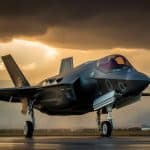Elon Musk, the billionaire entrepreneur behind SpaceX and Tesla, is stirring up a storm in defense circles with his bold statements about the future of air warfare. Tapped by US President-elect Donald Trump to spearhead efforts to streamline federal spending, Musk has turned his attention to the skies, labeling traditional fighter jets as relics of the past.
On his social media platform, X, Musk asserted that the era of manned fighter jets is over, advocating for a shift towards drone technology. His pointed remarks highlighted the vulnerabilities of manned jets, emphasizing risks to pilots and questioning their relevance in contemporary military strategy.
Musk specifically targeted the F-35 fighter jet, developed by US defense contractor Lockheed Martin, for criticism. Despite its cutting-edge stealth and intelligence capabilities, the F-35 has faced backlash due to its hefty price tag and complex development hurdles. Musk shared a video of drones operating seamlessly in formation, underscoring what he sees as the inefficiencies of manned aircraft like the F-35, which he described as an overbudget and overly ambitious project.
Defenders of the F-35 push back against Musk’s assertions. Experts argue that the fighter jet’s high cost is driven by its sophisticated electronics, not its pilots. A researcher from the Swiss Federal Institute highlighted the strategic advantages of the F-35, noting how it compels countries like Russia and China to revise their military strategies and budget allocations.
While Musk’s vision is compelling, the debate over drones versus manned aircraft is far from settled, as nations weigh the benefits and challenges of emerging technologies in military applications.
Are Traditional Fighter Jets Becoming Extinct? The Rise of the Drone Era and Its Impact on Humanity
Elon Musk’s recent proclamation about the obsolescence of manned fighter jets in favor of drones has sparked significant discussion regarding the future of military aviation. This shift towards unmanned aerial vehicles (UAVs) is not simply a matter of technological evolution but has deep implications for humanity and global conflict strategies.
Futuristic Warfare: The Leap to Drones
The transition from manned aircraft to drones represents a pivotal moment in military history, potentially altering the fabric of warfare as we know it. Drones offer distinct advantages, such as reduced risk to pilots’ lives and potentially lower operational costs. However, this change is not without its critics and controversies.
Implications for Global Conflict and Strategy
As nations move towards adopting drone technology, the military strategy landscape will undergo significant transformation. Drones could eliminate pilot fatalities, enabling risky missions without human risk. This might reduce war aversion, potentially leading to escalated conflicts. Furthermore, the reliance on advanced technology places substantial power in the hands of countries with the financial and technical resources to develop sophisticated UAV systems.
Technological Innovation or Pandora’s Box?
The rise of drones in military applications sparks innovation in AI and robotics. This has the potential to bolster technological progress in other fields such as logistics, surveillance, and even commercial sectors. However, there is a looming question: Could the increased autonomy in military drones turn ethical precision into a blanket of unchecked aggression and collateral damage?
Advantages and Disadvantages: A Double-Edged Sword
While drones provide unprecedented strategic advantages, offering enhanced surveillance and precise strikes, they also face significant drawbacks. Cybersecurity threats and the possibilities of hacking and commandeering drones raise serious concerns. Additionally, the ethical implications of AI-driven warfare remain a complex debate as nations grapple with the morality of removing human decision-making from life-and-death scenarios.
Click-Worthy Considerations: Will Human Elements Disappear from Warfare?
A critical question is whether the human element in warfare is fading. Could machines truly replace the decision-making prowess of a human pilot in complex combat environments? How will this shift affect military personnel training, and what roles will humans play in future conflicts dominated by drones?
As this evolution unfolds, expect military powers worldwide to intensively debate the trade-offs associated with replacing human-driven aircraft with UAVs. This transition will necessitate new doctrines, treaties, and ethical guidelines to control the deployment and engagement of such technology.
To follow the architectural changes shaping our world, visit New York Times and for insights on technology advancements, explore Washington Post.







